Strange as it seems there’s been a run of crazy dreams, and none quite so crazy as the new touring production of Andrew Lloyd Webber’s Joseph and the Amazing Technicolor Dreamcoat now appearing on the Opera House stage of the John F. Kennedy Center for Performing Arts. Presented by Independent Presenters Network under the Direction of Andy Blankenbuehler with Musical Direction by Wayne Green, this rebooted conceptualization of the hit musical is targeting a younger, modern audience with its choice of framework, heavily layered concepts, and leading performers.
The production’s overall aesthetic is striking; visually the show pops off the stage with the multi-colored costumes, intense light show, magnificent dancing, and the mesmerizing, albeit at times superfluously disjointed, use of projections. As musicals go, the pop-modern suffusion of riffs, alternate harmonies, and the overall vocal style that Ace Young and Diana DeGarmo bring to the principle roles are an acquired taste and do little to bring justice to the piece.
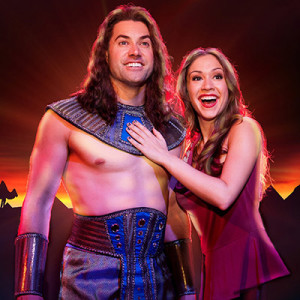
DeGarmo struggles to maintain strength while singing, unable to hold notes for sustained lengths of time the result of which is a clipped delivery of numbers like “Pharaoh’s Story” and “Jacob & Sons.” There are occasions where she able to produce a solid belt or two, but these are followed with ferocious riffs and sound out of place despite several of the newer orchestrations (provided by David Kreppel, Simon Lee, and Nigel Wright.) attempting to “rock-modernize” the musical. Her delivery of most numbers results in a nasally “head-voice” sound, which diminishes the beauty and power of her character’s songs. DeGarmo’s most rewarding moment is the concert rendition of “Any Dream Will Do” that she delivers as a duet with Young after the show has concluded.
Ace Young has similar struggles, though his vocal strength does prove to be more sound judging by the incredible sustain he finds at the end of “Close Every Door.” Much like DeGarmo, his sound is nasally and often does not resonate. There is a deep emotional connection that Young manages to unearth in the character, however, that helps atone for his uneven vocal delivery. Young’s facial and physical expressions leave something to be desired as they are a repetition of the same few gestures and emotions throughout the performance. Young does achieve a shining moment in “Go, Go, Go Joseph” where he is able to showcase his immaculate physicality, muscles, and chiseled bodily strength by flexing throughout the number as others dance around him.
The show’s biggest issues come from Director Andy Blankenbuehler’s multi-faceted conceptualizations; at best they are unclear. While Blankenbuehler opens the show with a modernized framework— a progressive dream that unfurls into real life through the ages— there is no connectivity that takes this concept into the actual setting of the musical and the two elements of pre-show framework and the show itself exist with no relation to one another. Blankenbuehler’s notion of when the show occurs also appears to drift in limbo somewhere between the 60’s and 70’s inspired costumes, the 80’s and 90’s rocker light show and the post-modern 2000-teens of the shows’ principle vocalists. The vast inconsistencies amid the design work— though separately they are exciting and striking to behold— create for a disjointed production on the whole.
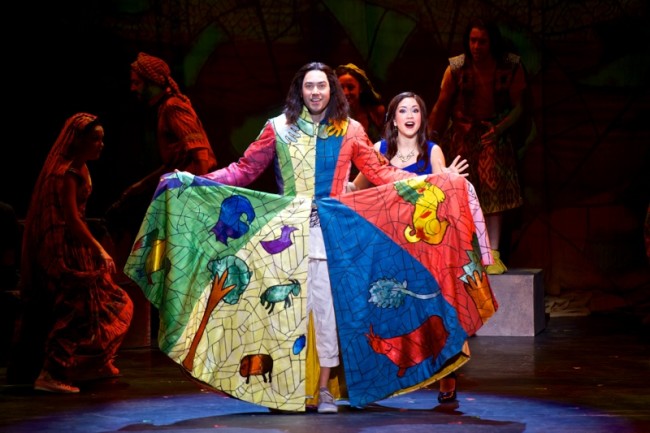
Video and projections are all the rage in every new musical in this day and age; it comes as no surprise that Blankenbuehler is making intense use of these design elements throughout the show. For the most part Video and Projection Designer Daniel Brodie’s are enchanting; scrolling maps, exotic desert scenery and bursts of color that are aligned with “Joseph’s Coat.” There are a few places where the projects seem to appear from nowhere, particularly the underwater exploration of dolphins frolicking, and don’t fit the action on stage but for the most part they create a unique and stunning visual enhancement to the production.
Lighting Designer Howell Binkley has laser lights and colors that cover ever shade in “Joseph’s Coat” which is truly an incredible accomplishment. Binkley’s blinking lights are so intense that at times they could be a separate show all their own. The fast and furious light work often drives the tempo of some of the more upbeat numbers, which enhances the overall experience. Binkley’s impressive array of colors projected clearly to reflect different shades and hues augment the Technicolor theme of the show wholeheartedly.
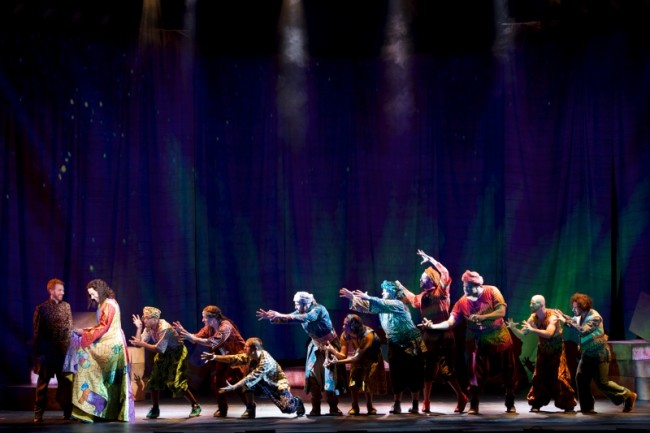
Similar colors are reflected in the threadwork of Costume Designer Jennifer Caprio. Though the era-influenced styles may be disconnected from the performance’s overarching existence, Caprio’s clothing recreates a multitude of colorful emotions. The brothers and wives wear these hues proudly but Caprio’s most impressive work is the Vegas showgirl costumes featured throughout Egypt. Shimmery gold with enormous blue headdresses (notably tinted to look like blue-suede) and all the right shiny materials for Pharaoh has Caprio earning her keep with her costumes. The use of all white for the “Joseph Megamix” dance-palooza is an exceptional touch that really highlights Binkley’s final bursts of his dazzling light show.
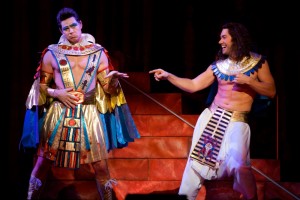
Watch out for Pharaoh (Ryan Williams) a true Elvis impersonator doing his best to work every gimmick and mimicry angle on the Vegas-Egyptian strip. Williams flirts shamelessly with the audience while throwing his best pelvic thrust in every direction his hips will swivel. Vocally sound, his rendition of “Song of the King” is a spectacle that is met with a light show and dancing girls that authenticate the “Vegas-Egyptian” experience.
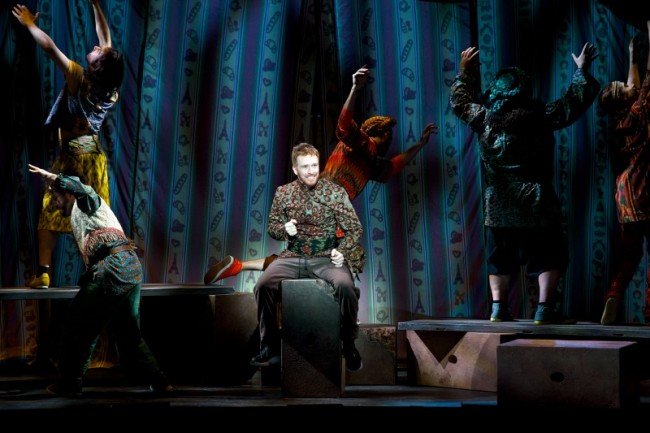
The brothers, though a bit melotheatric and too heavily involved in working a shtick bit for comic effect at times, have superb voices that really carry the original orchestrations of the musical. Simeon (Paul Castree) leads the brothers in “Those Canaan Days” and this becomes one of the most spirited and amusing numbers in the performance. The Acapella chorus play that results near the end of the number is both a showcase of superior ensemble talent and a fun and fanciful moment for the audience to enjoy. Reuben (Brian Golub) and his Wife (Christine Cornish Smith) deserve similar praise for their strong vocals when they lead “One More Angel in Heaven.” Smith’s melodic voice floats high into the rafters as the “angel” in this number while Golub works comic ease into the number with his smooth indulgent sound.
Blankenbuehler does hit the mark conceptually by redesigning the introduction to the “Benjamin Calypso” with Judah (Max Kumangai) throwing himself before Joseph in a slow-motion and emotionally serious startup to the number before bursting into a fully island-flavored song. Kumangai has a robust and radiant sound that leads this song to the jovial place it is meant to go; his resilient joviality ringing through the number with resplendent ease. The ears of the audience can attend Kumangai in this number but all eyes should track Benjamin (Brandon Hudson) as he performs a series of acrobatic dance tricks well worth noting.
There is a great deal of talent loaded into the ensemble, particularly their dance ability. While Blankenbuehler may be conceptually confused, as the show’s Choreographer he shines as a dazzling star. The dancing seen in the production is spectacular and is strong enough to forgive the disappointment of the leading performers. Frenetic energy pulses through the ensemble for the speeded version of “One More Angel in Heaven” resulting in a Riverdance style tap-off at a wild-west hootenanny. The synchronization experienced throughout the dance routines is consistent, solid, and tight; no one ever appearing out of place in the complex routines. The tail end of “Those Canaan Days” results in a hilarious and clever table-dance routine which thoroughly entertains the audience. Blankenbuehler’s choreography for the “Joseph Megamix” could easily be a stand-alone performance for all of the intricate moves he maps therein.
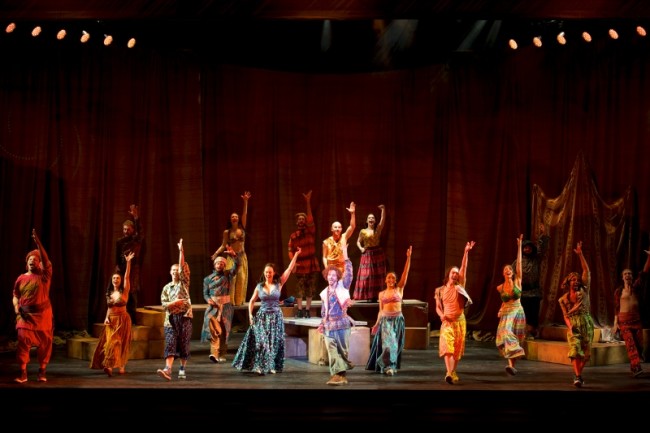
Go, go, go for the dancing and the talent that is bursting at the seam in the ensemble; this limited engagement run won’t stick around long with dancing this impressive!
Running Time: Approximately 1 hour and 50 minutes with one intermission
Joseph and the Amazing Technicolor Dreamcoat plays through January 4, 2015 on the Opera House stage of the John F. Kennedy Center for Performing Arts— 2700 F Street NW in Washington, DC. For tickets call the box office at (202) 467-4600 or purchase them online.

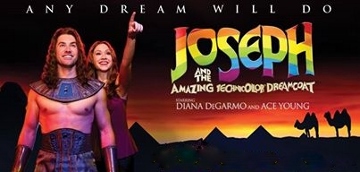
Seriously!?! Just saw this at the Kennedy Center. It is AWFUL, AWFUL, AWFUL.
The guys doing the Canaan song were great! The rest of the show was embarrassing. I have not seen a high school musical as painful as this thing is. The Direction was just bad. It didn’t flow. Scenes and actions didn’t match the lyrics. It was as though the Director didn’t even listen to the lyrics.
Ace’s voice – so nasal, it is almost comical. When he starts to sing you can hear the brakes squealing as the show grinds to a halt. Who would cast this guy!?!
Don’t waste your time or money.
To be fair – the motion graphics and the lighting were well done. A high school would have loved to have that level of production when it comes to effects. It didn’t help this thing. ugh!